As you venture into the Philippines' most spectacular caves, you'll discover a diverse array of cave systems, each featuring unique geological formations, diverse wildlife, and significant historical and cultural significance. Over 7,000 islands boast extensive cave networks, including the longest navigable underground river at 8.2 kilometers. You'll find naturally formed swimming pools, stunning crystal formations, and even historical burial grounds. To guarantee a safe and enriching experience, guided tours with expert navigation and necessary equipment are recommended. By planning ahead and staying informed, you'll be prepared to fully appreciate the Philippines' most spectacular caves and uncover the secrets they hold.
Overview of Caving in the Philippines
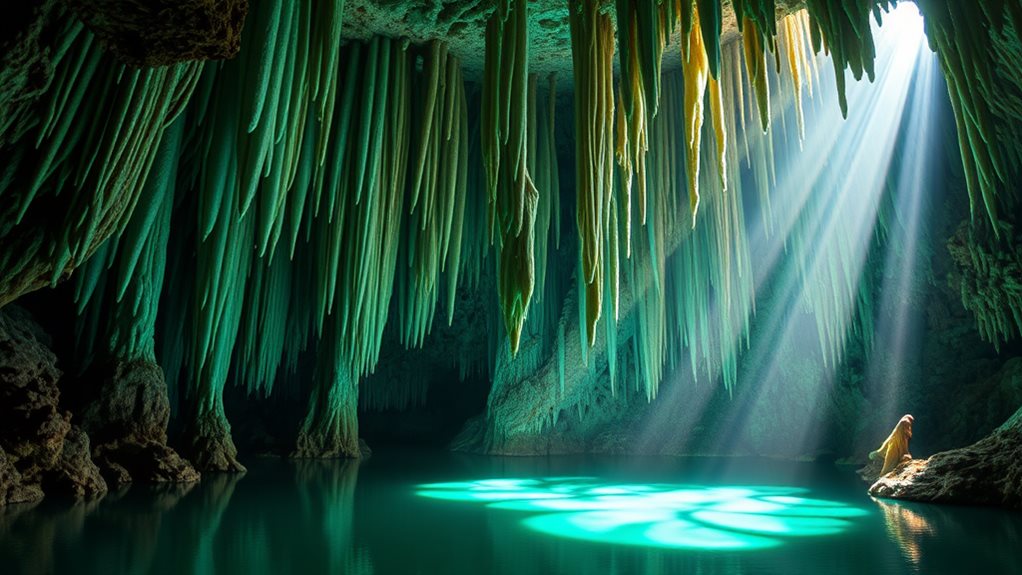
The Philippines boasts an extensive and diverse network of caves, a demonstration of its complex geological history. You'll find over 7,000 islands in the archipelago, each with its own unique caving experiences that cater to both beginners and expert spelunkers.
As you explore these caves, you'll encounter several key geological formations, including striking limestone rocks that form the backbone of many cave systems.
These caves often feature notable landmarks, such as the iconic Puerto Princesa Underground River, which exhibits remarkable geological formations and supports a rich biodiversity. As an eco-tourism destination, it attracts a significant number of visitors each year.
In addition, caves in the Philippines hold immense archaeological importance, like the Tabon Caves, which yield valuable information about the history of human habitation in the region.
The Philippines' cave network offers a range of activities designed for both adventure seekers and nature enthusiasts. Exploring these caves involves hiking, observing rock formations, and in some cases, swimming in underground pools.
This combination of factors makes the Philippines an ideal destination for those interested in underground marvels. As you immerse yourself into the world of caving in the Philippines, you'll discover a complex and fascinating environment that highlights the country's complex geological and cultural history.
Notable Caves and Their Features
Located on various islands throughout the archipelago, the Philippines is home to an impressive array of notable caves, each with its own unique features and geological formations. You'll find some of the country's most stunning caves, showcasing nature's craftsmanship in intricate details.
One of the country's most celebrated caves is the Puerto Princesa Underground River, nestled within the UNESCO World Heritage Site in Palawan. Spanning 8.2 kilometers, this underground river isn't only the longest navigable one in the world but also offers a chance to explore the cave's natural beauty.
Moving further to the north, you'll find Calbiga Cave, the largest in the country, which measures 7 kilometers in length and boasts impressive stalactites and stalagmites that have taken centuries to form. The cave's vastness and rock formations make it a favorite among spelunkers.
In addition to the above-mentioned caves, the Aglipay Caves in Quirino Province showcase eight accessible caves within a 101-hectare area, offering unique rock formations and diverse wildlife.
Hinagdanan Cave in Bohol is renowned for its beautiful rock formations and a natural swimming pool, attracting numerous visitors each year.
Meanwhile, the Sumaging-Latipan-Lomyang Crystal cave in Sagada is famous for its stunning crystal formations and serves as a historical burial ground, highlighting the intersection of natural wonders and cultural significance.
Historical and Cultural Significance of Caves
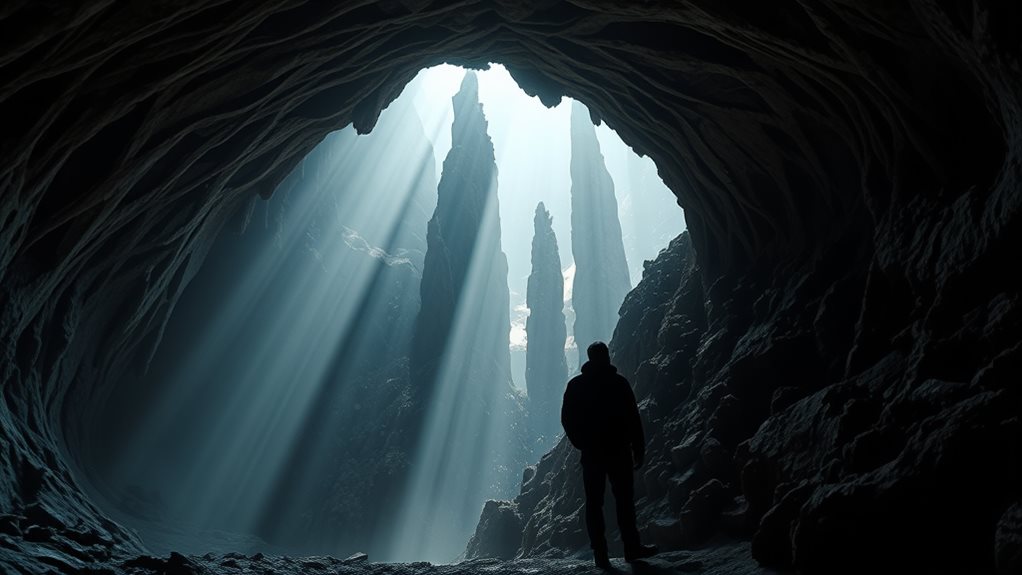
We often overlook the fact that caves have played a significant role in human history. You might be surprised to learn that many caves in the Philippines have served as historical refuges, guerrilla strongholds, and cultural sites significant to the country's story.
Take the Tabon Caves in Palawan, for instance, which are recognized as the "cradle of civilization" in the Philippines. These caves house ancient human remains, including the Tabon Man, which dates back to 14,000 B.C.
Similarly, Biak na Bato served as a historical refuge for Filipino rebels during Spanish colonization, providing valuable insights into the country's fight for independence.
During World War II, the Sumaging-Latipan-Lomyang Crystal Cave in Sagada was utilized as a guerrilla stronghold, showcasing its strategic importance in Philippine history.
The Aglipay Caves, known for their unique rock formations, are also a local pilgrimage site, pointing out the cave's cultural significance.
Even cave systems like Callao Cave feature a chapel within one of its chambers, blending natural beauty with religious significance.
When visiting these caves, it's crucial to appreciate the historical and cultural context that surrounds them. They're more than just natural wonders, but rather windows to the Philippines' rich past.
Adventure Activities in Caves
Besides the breathtaking scenery, caving experiences in the Philippines present a diverse range of adventure activities that cater to various interests and physical abilities. As you explore the Philippines' most spectacular caves, you'll have the opportunity to hike, swim, rappel, and even wildlife observe amidst unique geological formations.
For instance, the Sumaging-Latipan-Lomyang Crystal Cave in Sagada is perfect for swimming and rappelling among stunning crystal formations. If you're up for a thrilling challenge, the Odloman Cave in Negros Oriental requires you to swim or enter through a roof hole, leading to large galleries and narrow passages for exploration.
Meanwhile, the renowned Puerto Princesa Underground River features a serene boat ride through its 8-kilometer navigable underground river. Take the opportunity to witness diverse wildlife and unique rock formations that will leave you in awe.
Venture into the cave systems with a guided tour, and guarantee your safety while gaining invaluable insights into the cave's geology and history. Explore into the heart of the earth, where intricate rock formations and eloquent stalactites will leave you in wonder.
As you explore deeper into the cave, wildlife observation becomes a must, as you spot exotic creatures in their natural habitats. Whether you're an adventure-seeker or a nature enthusiast, caving experiences in the Philippines promise to deliver an unparalleled adventure like no other. Experience it for yourself, and uncover the secrets hidden within the country's most spectacular caves.
Eco-Tourism and Conservation Efforts
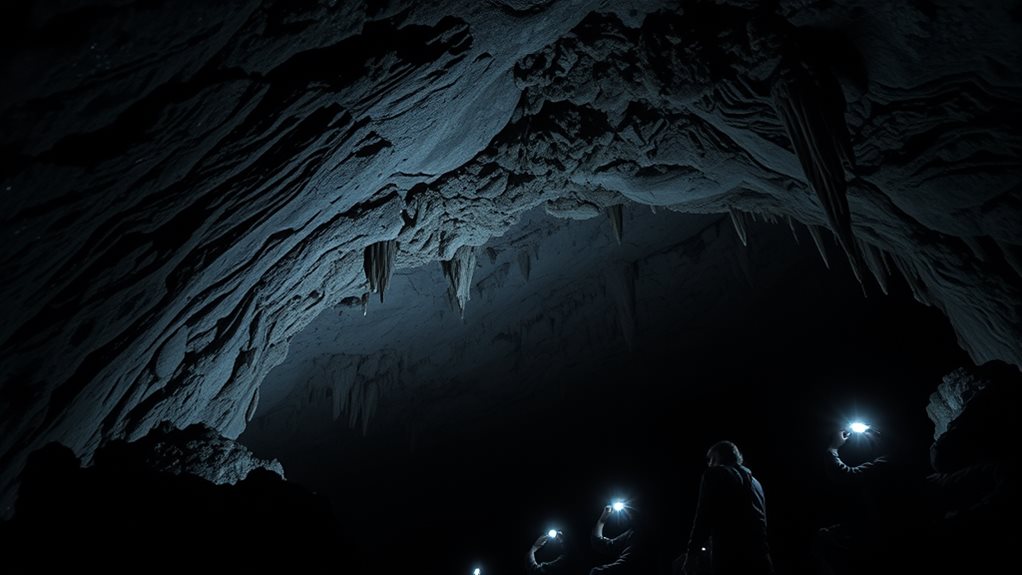
The Philippines adopts a holistic approach to cave tourism, incorporating eco-friendly practices and conservation initiatives to safeguard unique geological formations and ecosystems within its cave systems.
You'll notice that many tour operators and cave administrators prioritize eco-friendly tours, which minimize human impact and promote responsible travel. These initiatives often involve education and community involvement, raising awareness about the ecological significance of caves and the importance of conservation.
In areas like the Puerto Princesa Underground River, a UNESCO World Heritage Site, conservation initiatives are underway to protect sensitive ecosystems and preserve natural habitats for diverse wildlife.
Local regulations and community involvement play an essential role in mitigating vandalism and guaranteeing the protection of these sites. Educational tours, such as those at the Monfort Bat Sanctuary, highlight the need for bat conservation and raise awareness about the ecological importance of these fascinating creatures.
Ongoing assessments and collaborations between government and non-governmental organizations aim to strike a balance between tourism activities and ecological preservation.
These efforts guarantee that caves remain accessible while safeguarding their natural beauty for future generations. By embracing eco-friendly tourism practices and community-driven conservation initiatives, the Philippines is setting a precedent for responsible cave tourism.
Visitors like you can contribute to these efforts by choosing eco-friendly tour operators, respecting local regulations, and supporting conservation initiatives.
Vacation Packages and Travel Guides
When planning a trip to the Philippines, vacation packages offer a convenient and often cost-effective way to experience the country's diverse attractions, including its most spectacular caves. You can opt for tailored packages that cater to your interests and budget, allowing you to explore the Philippines' underground wonders without the hassle of arranging logistics.
Bohol vacation packages, for example, combine caving experiences with beach resorts and adventure tours, while Palawan vacation packages provide thorough guided tours to notable caves and island hopping adventures. The Puerto Princesa Underground River, a UNESCO World Heritage Site, is a must-visit destination.
Baguio vacation packages, on the other hand, integrate caving experiences with cultural site visits and local tradition explorations.
Travel guides for Palawan offer detailed insights into visiting the region, including information on accommodations, activities, dining, and must-visit caves. These guides guarantee that you make the most of your trip and fully appreciate the natural beauty of the Philippines.
For those seeking a more extensive adventure, combination trips are also available, integrating caving tours with activities like scuba diving and snorkeling.
To maximize your experience, prepare by researching local regulations and precautions for caving and exploring underground sites. Prioritize responsible tourism practices, respecting local ecosystems and adhering to environmental guidelines. Proper guidance from experts guarantees a safe and successful expedition.
Popular Cave Tours
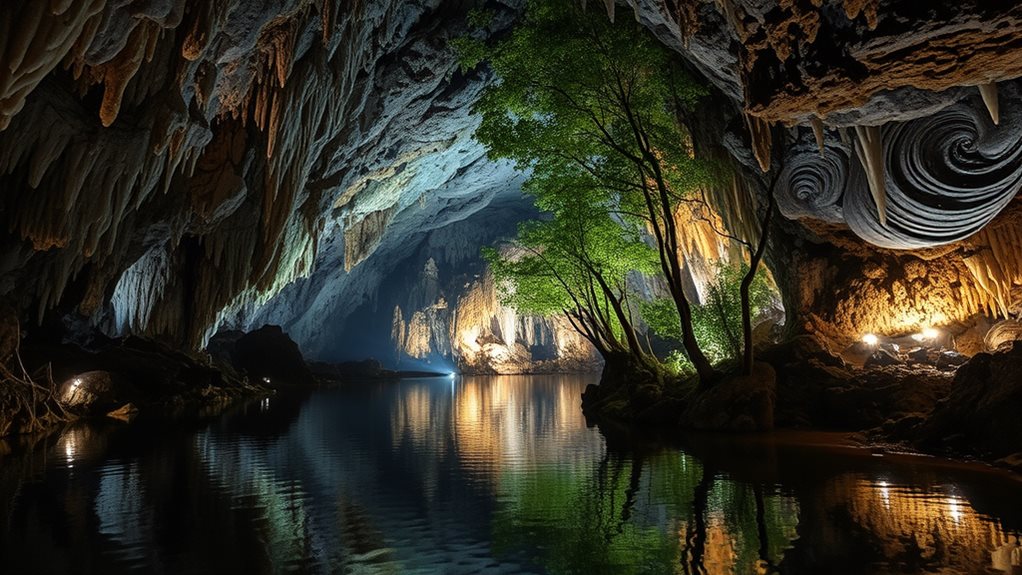
For cave enthusiasts, the Philippines offers a plethora of options for exploring its underground wonders. You can choose from a range of popular cave tours that cater to different interests and skill levels. Each tour offers a unique experience, from serene boat rides to challenging hiking and climbing excursions.
Whether you're a nature lover, an adventure seeker, or simply looking for a budget-friendly activity, the Philippines has something to offer.
If you're interested in a unique underground river tour, head to the Puerto Princesa Underground River, a UNESCO World Heritage Site that spans 8.2 kilometers. You'll set off on a serene boat ride through the river's crystal-clear waters, taking in the stunning rock formations and diverse wildlife.
Alternatively, visit the Sumaging-Latipan-Lomyang Crystal Cave in Sagada for a hiking and climbing adventure that combines stunning crystal formations with a historical burial ground.
For a more leisurely experience, consider exploring Callao Cave, which features seven accessible chambers, including a chapel within one of the chambers. You'll get to see unique rock formations up close and take in the peaceful atmosphere of this natural wonder.
If you're looking for a budget-friendly option, head to the Aglipay Caves, which features eight accessible caves known for their unique rock formations and diverse wildlife, all for a mere 25 pesos entrance fee.
Unique Geological Features of Caves
Glacial dissolution and karstic processes have given rise to some of the most spectacular geological formations found in the Philippines' cave systems. You'll witness these formations firsthand in the country's numerous caves, each offering a unique look into the region's geological past.
The Puerto Princesa Underground River, a UNESCO World Heritage Site, is particularly impressive, featuring stunning limestone formations that stretch as far as the eye can see.
In other caves, like the Sumaging-Latipan-Lomyang Crystal Cave in Sagada, you'll find breathtaking crystal formations that have taken centuries to develop. This cave, in fact, holds the title of the deepest in the Philippines, with depths reaching a staggering 163 meters. Here, you can observe the intricate details of these crystals up close, a true marvel of geological processes.
Meanwhile, the Tabon Caves in Palawan offer a glimpse into the Philippines' early human history, alongside unique rock formations that have been shaped by thousands of years of weathering.
Caves like Hinagdanan in Bohol are also notable for their impressive natural stalactites and stalagmites, a result of the slow dripping of mineral-rich water over time.
The Calbiga Cave system in Eastern Samar, the largest in the Philippines, is a wonder in its own right, featuring enormous chambers that resemble colossal sports arenas. These formations serve as a demonstration of the powerful forces that have shaped the country's geology over millions of years.
Cave Exploration and Safety
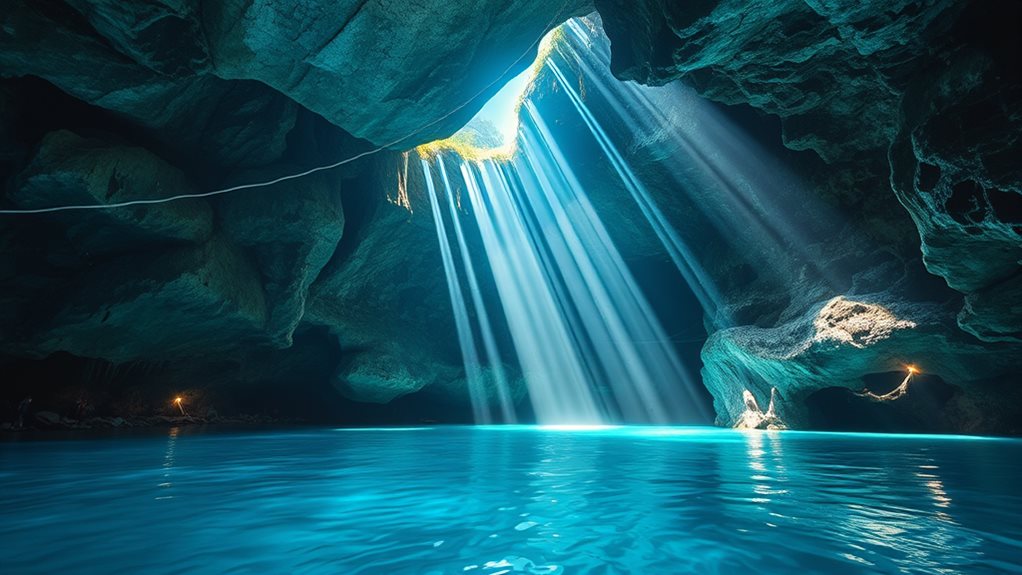
Safety is of utmost importance when venturing into the Philippines' caves, given the vast network of underground passages and the potential risks that come with exploring unfamiliar terrain. To guarantee a safe and enjoyable experience, you should always wear sturdy footwear and comfortable clothing that allows for ease of movement through varying terrains. This is vital when maneuvering through narrow passages, uneven rock, and potential waterlogged areas.
When venturing into caves for the first time, it's recommended to join guided tours. These tours provide access to safety equipment and expert instructions on how to navigate potential hazards. For instance, caves like Odloman Cave and Calbiga Cave require swimming or climbing, so being physically prepared is essential. Make sure to familiarize yourself with emergency procedures before entering, such as communication protocols and exit routes.
In addition to physical preparation, it's also important to respect the caves' natural formations and local regulations. Inspectors rely on visitors to help preserve the caves' beauty, so it's important to follow rules and guidelines provided by tour guides.
Follow emergency procedures, and take note of your surroundings to guarantee a safe experience for yourself and others. At all times, maintain awareness of your body position, balance, and equipment.
For inexperienced cavers, joining a guided tour is a must to minimize risks and take full advantage of the unique beauty that the Philippines' caves have to offer. Staying informed and vigilant is key to a successful cave exploration experience.
Philippine Cave History and Lore
As you've learned how to navigate caves safely in the Philippines, it's time to uncover the hidden histories and tales that lie within these rugged labyrinthine formations.
The Tabon Caves in Palawan, considered the "Cradle of Philippine Civilization," are significant for housing the remains of Homo Sapiens, including the Tabon Man, dating back to 14,000 B.C. This provides valuable insights into the early history of human habitation in the Philippines.
Throughout the country's history, caves have served as historical refuge for those seeking asylum or hiding from conflict. During the Spanish colonization, Biak na Bato was a hiding spot for Filipino rebels, offering a glimpse into the country's struggle for independence.
Similarly, the Sumaging-Latipan-Lomyang Crystal Cave in Sagada was used as a hiding spot by guerillas during WWII, highlighting its role in Philippine history. The Aglipay Caves in Quirino Province feature unique rock formations that attract visitors, but also hold historical significance as a pilgrimage site during the Spanish era.
The Callao Cave showcases a chamber used as a Roman Catholic chapel, demonstrating the convergence of natural wonders and cultural practices in the Philippines.
These examples illustrate the multifaceted role that caves play in understanding Philippine history and culture. By exploring these underground marvels, you'll gain a deeper appreciation for the significance that caves have played in shaping the country's identity.
Are There Caves Near the Hidden Waterfalls Worth Exploring in the Philippines?
Nestled amidst lush greenery, the hidden waterfalls in the philippine islands often conceal mystical caves waiting to be explored. These natural wonders offer adventurers a glimpse into unique rock formations, serene pools, and ancient secrets carved over centuries, making them a captivating destination for thrill-seekers and nature enthusiasts alike.
Caving Experiences for Beginners
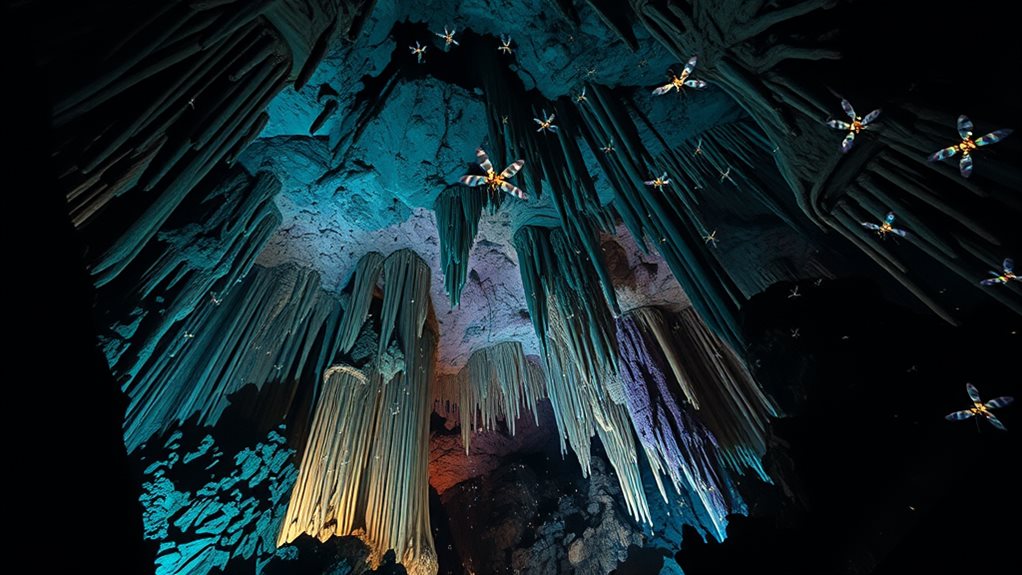
The Philippines offers a diverse range of beginner-friendly caving experiences that cater to adventurers of all skill levels. With numerous accessible caves scattered across the country, you can immerse yourself in the country's rich geological heritage without feeling overwhelmed.
Take the Aglipay Caves in Quirino, for instance, which boasts eight chambers and a minimal entrance fee of 25 Pesos (approximately $0.50 USD).
If you're looking to explore farther, head to Bohol's Hinagdanan Cave, which features stunning stalactites and a swimming area with crystal-clear waters. Not only is it an ideal spot for exploration and photography, but it's also a great way to ease into caving.
Guided tours are widely available in notable caves like Callao Cave and the world-renowned Puerto Princesa Underground River, guaranteeing your safety and providing expert insights as you navigate the underground world.
When participating in caving experiences, prioritize comfort and safety. Wear sturdy footwear and comfortable clothing, as activities like hiking and swimming are often included in the experience.
For a unique perspective on spelunking, consider accessing caves like Sohoton Cave via small boats, offering a chance to appreciate the surrounding landscapes while introducing you to the basics of caving.
With professionalism and attention to detail, guided tours guarantee that your caving experiences are both enjoyable and educational, making the Philippines an ideal destination for those new to caving.
Destination Guides and Resources
With your caving experiences under your belt, you're likely itching to explore more of the Philippines' vast and varied cave systems. As you plan your next caving adventure, you'll want to consult reliable destination guides and resources to make the most of your time. Here are some must-visit spots to add to your itinerary.
The Puerto Princesa Underground River, a UNESCO World Heritage Site, is a must-come, must-see attraction. Not only is it home to the longest navigable underground river at 8.2 kilometers, but its cave system also boasts impressive geological formations and a variety of wildlife.
You'll need to plan ahead and book a guided tour to experience this incredible site.
If you're looking for more unique geological formations and adventure activities, consider visiting the Sumaging-Latipan-Lomyang Crystal Cave in Sagada. This cave features stunning crystal structures and offers opportunities for rappelling and swimming.
Alternatively, head to the Aglipay Caves in Quirino Province, which consist of 37 interconnecting chambers, featuring impressive rock formations and a natural chapel.
Other notable caves include the Callao Cave in Cagayan and the Calbiga Cave in Eastern Samar, both offering a range of adventure activities and historical significance.
To guarantee a safe and enjoyable experience, be sure to consult local guides and resources before starting on your caving adventure.